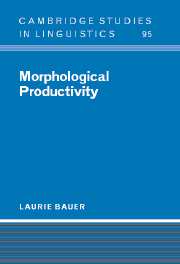7 - Conclusion
Published online by Cambridge University Press: 22 September 2009
Summary
Productivity is one of the central mysteries of derivational morphology.
Aronoff (1976: 35)In this conclusion it is my aim to tease out some of the threads that have been discussed in the previous chapters and present a unified view of morphological productivity. I shall also consider briefly the extension of the notion of productivity into other areas of linguistics.
Productivity summarised and defined
Availability and coinage
We are now in the position to divide morphological productivity into two distinct themes: availability and profitability. A morphological process is available if it can be used to produce new words as they become necessary. Availability is a yes/no question: either a morphological process is available or it is not. We might, however, ask more precise questions about availability and ask whether or not a particular morphological process is available with a certain type of base. For example, we might ask whether -ment is available with bases ending in -ise (answer in current English: no), or whether -ation is available with the same set of bases (answer in current English: yes). In principle a yes/no answer will be available for classes of base defined by any of the constraints discussed in section 5.2. In practice it might be more difficult, or there might be cases of uncertainty. This does not alter the fundamental principle that availability is an either-or, and that things are either productive or unproductive in this sense, with no middle ground.
- Type
- Chapter
- Information
- Morphological Productivity , pp. 205 - 223Publisher: Cambridge University PressPrint publication year: 2001

